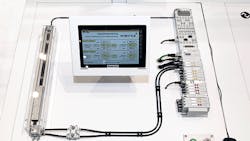This file type includes high-resolution graphics and schematics when applicable.
The Internet of Things (IoT) shouldn’t be an idealized cloud—it needs to provide real advantages to users. IoT is already a buzzword in the automation industry, with few other topics receiving as much press. But not many people are aware that, from an automation perspective, IoT is not a revolution, but a gradual evolution over the past few years toward networked components, modules, and machines. And you’d be hard-pressed to find other technologies that demonstrate this development better than pneumatics combined with decentralized electronics.
One such example is the AV series valve system from Aventics. These compact pneumatic valves are as small as a credit card and weigh about half as much as comparable valves. This makes AV valves a logical choice for decentralized arrangements near actuators. Modularization in mechanical engineering becomes much easier because function groups can be fully preassembled without a control cabinet.
Decentralized Signal Processing
Valve electronics supplied by Aventics’ Advanced Electronic System (AES) meet increasingly demanding networking requirements. It regulates up to 64 decentralized valves that have as many as 128 coils.
An important feature for the IoT is that engineers can extend the valve electronics by up to 10 I/O modules. The AES uses these modules to handle the process signals where they’re generated, as well as control individual actuators outside the valve system. This reduces wiring considerably, since the sensors and actuators are not connected to the control cabinet, but to the nearby valve system that features flexible positioning for application requirements.
In addition, the decentralized I/O modules offer potential for further modularization. That’s because only two cables for power and communication are needed to connect all pneumatic valves, sensors, or actuators linked to the AES with the higher-level control. This fully modular setup results in a practical side effect for end consumers, too: A subsequent expansion or conversion of installed systems becomes much easier.
Open Communication Standards
The Internet of Things demands shared protocols and interfaces across all levels and technologies. Data is exchanged via real-time Ethernet. Various open standards and manufacturer-specific interfaces currently compete within this field, which makes things more complex for machine manufacturers because customer requirements may demand the use of specific protocols.
The AES electronics support all conventional fieldbuses and Ethernet protocols. They meet the basic requirements for a seamless information transfer from company IT via machine control to the pneumatic actuator and back again.
Reliable and Readily Available
Valve electronics record and prepare operational and diagnostics data, thus improving process reliability and quality monitoring. Motion, pressure, and other parameters are continuously monitored by sensors and the results documented. Say, for example, a cylinder’s pressure drops, and an action is carried out with insufficient force or precision. This can be detected, and the electronics will issue an error message. Without these checks, an expensive mistake might not be caught until the final inspection.
The data can also be used for systematic condition monitoring. Internal data record assessments indicate wear occurring on individual valves, cylinders, or other mechanical components before there’s a failure. Maintenance personnel can then replace the component during a scheduled production break. This results in considerably higher system and machine availability.
Internal Data Processing without Programming
This topic exemplifies the evolutionary development of the IoT. Advanced valve electronics have long supplied process and diagnostics data. With AES valve electronics, however, the machine manufacturer or system integrator no longer needs to program the diagnosis or status functions for pneumatics in the control because they’re already integrated in the AES.
The electronics system records local data independent of the control and prepares and supplies them to users for further processing—a scenario similar to smartphone apps. Because of the Ethernet connection, retrieval can occur from any location with the appropriate permission. Both internal maintenance personnel and authorized service providers can use system monitoring to increase the system availability.
Flexible for Small Batches
A key aspect of the IoT in the industrial context is the flexible production of small batches down to a single item. At the same time, nearly all sectors need to adjust to increasingly short product lifecycles. This has consequences for production equipment. Assembly and handling equipment in particular will now be converted more frequently and adapted to new products. Because they’re very modular and accommodate a wide variety of operating parameters, pneumatics can be quickly adapted to new tasks in intelligent industrial environments. This may all seem revolutionary, bit it is truly evolutionary.
Dieter Michalkowski is Global Account Manager and Internet of Things expert with Aventics GmbH. For more information, contact Aventics USA at (859) 259-3817, or visit www.aventics.us.
About the Author

Leaders relevant to this article:



